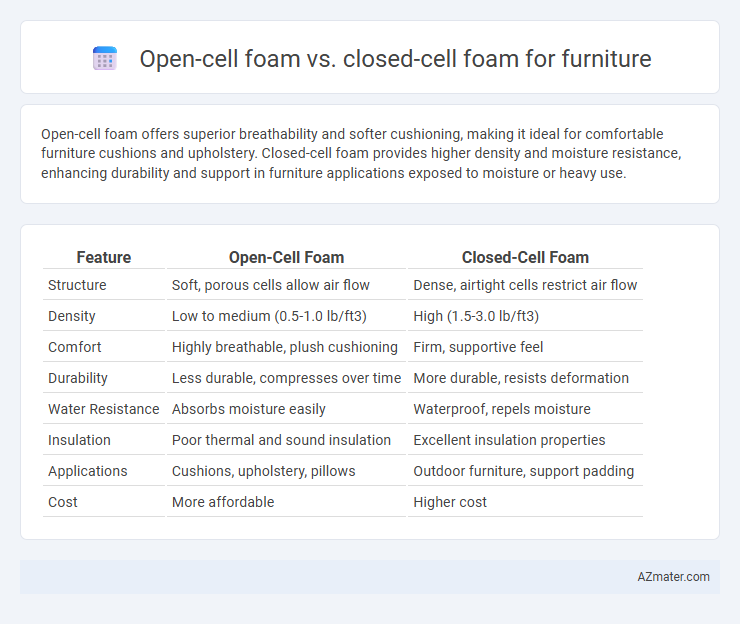Open-cell foam offers superior breathability and softer cushioning, making it ideal for comfortable furniture cushions and upholstery. Closed-cell foam provides higher density and moisture resistance, enhancing durability and support in furniture applications exposed to moisture or heavy use.
Table of Comparison
| Feature | Open-Cell Foam | Closed-Cell Foam |
|---|---|---|
| Structure | Soft, porous cells allow air flow | Dense, airtight cells restrict air flow |
| Density | Low to medium (0.5-1.0 lb/ft3) | High (1.5-3.0 lb/ft3) |
| Comfort | Highly breathable, plush cushioning | Firm, supportive feel |
| Durability | Less durable, compresses over time | More durable, resists deformation |
| Water Resistance | Absorbs moisture easily | Waterproof, repels moisture |
| Insulation | Poor thermal and sound insulation | Excellent insulation properties |
| Applications | Cushions, upholstery, pillows | Outdoor furniture, support padding |
| Cost | More affordable | Higher cost |
Introduction to Foam Types in Furniture
Open-cell foam in furniture offers breathability and softness, making it ideal for cushions and upholstery with enhanced comfort. Closed-cell foam provides higher density and durability, offering superior support and resistance to moisture and deformation. Choosing between these foams depends on factors like desired firmness, longevity, and application in furniture design.
What is Open-Cell Foam?
Open-cell foam is a type of polyurethane foam characterized by its porous, breathable structure, with cells that are intentionally left open to allow air and moisture to pass through. It provides a softer, more flexible cushioning ideal for furniture that requires comfort and pressure relief, such as sofas and mattresses. This foam is lightweight, offers good sound absorption, and is less dense compared to closed-cell foam, making it a popular choice for upholstery and seating applications.
What is Closed-Cell Foam?
Closed-cell foam is a dense, rigid material characterized by its tightly packed cells that are completely enclosed, creating a waterproof and highly durable structure ideal for furniture applications. It offers superior insulation, resistance to moisture, and enhanced support compared to open-cell foam, making it suitable for outdoor furniture or high-traffic seating. The material's robust composition contributes to long-lasting cushions and padding that maintain shape and comfort over time.
Key Differences: Open-Cell vs Closed-Cell Foam
Open-cell foam features a softer, more flexible structure with air-filled cells that enhance breathability and cushioning, making it ideal for comfortable furniture padding. Closed-cell foam is denser and more rigid, providing superior water resistance, durability, and support, commonly used in furniture requiring structural integrity and moisture protection. Understanding the differences in density, water absorption, and cushioning properties helps select the appropriate foam type for specific furniture applications.
Comfort and Support: Which Foam Performs Better?
Open-cell foam offers superior comfort due to its softer, more breathable structure that conforms closely to body contours, ideal for cushioning in furniture. Closed-cell foam provides better support thanks to its denser, more rigid composition that resists compression and maintains firmness over time. For furniture applications prioritizing both comfort and long-lasting support, a combination of open-cell foam for softness and closed-cell foam for stability often delivers the best performance.
Durability and Longevity Comparison
Open-cell foam, characterized by its soft and breathable structure, offers moderate durability but tends to compress and degrade faster under heavy use compared to closed-cell foam. Closed-cell foam features a denser, rigid composition that provides superior resistance to moisture, mold, and physical wear, ensuring greater longevity in furniture applications. For long-term durability, closed-cell foam is a preferred choice due to its enhanced structural integrity and resilience against environmental factors.
Moisture Resistance and Breathability
Closed-cell foam offers superior moisture resistance due to its dense, impermeable structure that prevents water absorption, making it ideal for furniture in humid environments. Open-cell foam excels in breathability, allowing air to flow through its porous matrix, which enhances comfort and reduces heat retention in seating cushions. Selecting between these foams depends on balancing moisture resistance needs against ventilation and softness requirements for optimal furniture performance.
Cost Difference: Open-Cell vs Closed-Cell Foam
Open-cell foam typically costs less than closed-cell foam due to its lower density and open structure, making it a budget-friendly option for furniture cushioning. Closed-cell foam is denser and more durable, resulting in higher pricing but providing better support and longevity. The cost difference reflects the performance benefits of closed-cell foam, which often justifies its premium in high-use or outdoor furniture applications.
Best Applications for Each Foam Type
Open-cell foam, characterized by its porous structure and breathability, is ideal for furniture requiring softness and cushioning, such as upholstered sofas, chairs, and mattress toppers where comfort and airflow are priorities. Closed-cell foam offers superior durability, water resistance, and structural support, making it suitable for furniture exposed to moisture or heavy use, including outdoor seating, high-density cushions, and protective padding. Selecting foam based on application enhances furniture performance by balancing comfort, support, and longevity tailored to specific environmental and usage conditions.
Choosing the Right Foam for Your Furniture
Open-cell foam offers excellent breathability and softness, making it ideal for furniture that requires comfort and cushioning, such as sofas and armchairs. Closed-cell foam provides superior durability and moisture resistance, which is beneficial for outdoor furniture or pieces exposed to heavier wear. Selecting the right foam depends on balancing factors like comfort, longevity, and environmental exposure to ensure optimal performance and satisfaction.

Infographic: Open-cell foam vs Closed-cell foam for Furniture
 azmater.com
azmater.com